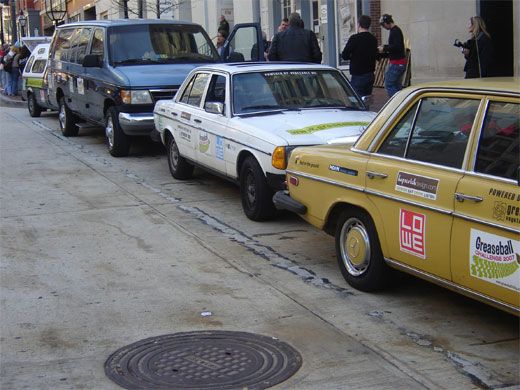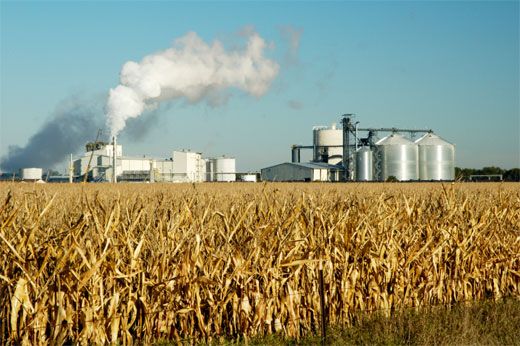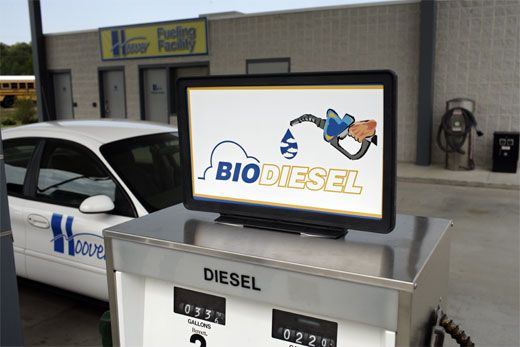The World After Oil
As the planet warms up, eco-friendly fuels can’t get here fast enough
/https://tf-cmsv2-smithsonianmag-media.s3.amazonaws.com/filer/biofuel-factory.jpg)
On a calm, chilly morning in late March, the four challengers pulled up to the first leg of the 3,500-mile pilgrimage that would, at best, rally awareness for alternative fuels between Washington, D.C. and Costa Rica and, at worst, leave them stranded somewhere in between. Already they were an hour behind schedule. Emily Horgan, the leader of this renewable rat pack, this carbon-neutral crew, inspected her entry: a 1976 mustard-colored Mercedes Benz, splotched with equal parts rust and bumper stickers, that had not been running days earlier. Another Benz, a cargo van and a Volkswagen Rabbit—each flashing bumper stickers of the same quality and quantity—parked behind Horgan. (There was supposed to be a biofuel bus, but it broke down.) A line of elementary school students, dressed uniformly in blue fleece, don't-lose-me fashion and waiting to tour Ford's Theatre, read the stickers' drive-by literature: "This car is powered by fast food grease."
For this pilot run of the Greaseball Challenge, the energetic, dark-eyed Horgan, originally from Reading, England, had gathered some biofuel experts, a Norwegian film crew and a few general adventurers. "There's a lot of awareness about biofuel, but not a lot of knowledge," Horgan, an environmental consultant for the International Finance Corporation, told me that morning. "We want to get a sense of good local projects." This itinerant quest for knowledge will bring the teams to Guatemala to meet biofuel developers running the company Combustibles Ecologicos, or Ecological Fuels; Costa Rica to learn about fuel made from banana waste; Willie Neslon's ranch in Austin, Texas, to fill up at Nelson's onsite biodiesel pump (and listen to his upcoming album); and possibly any number of auto-shops along the way.
Someone had handed the school students additional bumper stickers, and they began placing them on the white 1984 Mercedes with haphazard abandon. "How many are we putting on there?" Ben Shaw, the car's driver, asked the children. "Not too many, I hope. Let's keep it down to five or six." Horgan later explained how the grease cars worked: A simple black switch on the center console allows the driver to toggle between biodiesel, which must be used to start the car, and grease, which powers it. "Flip it to this side, you get biodiesel," she said. "Flip it here, veggie power." A button off to the side purges the grease right before parking the car, a task that also requires diesel. The change doesn't affect the car's performance or how many miles it gets per gallon.
In the larger scheme, grease isn't a very practical alternative fuel. These crews are using it because it will be easier to acquire and store. (Just the afternoon before, someone had whipped up for Horgan an emergency batch of papadum and samosa grease.) Biofuel, which refers to fuel made mostly from plants, is practical, however, and a lot closer to mainstream than the average person might believe.
"Biofuel could be produced in substantial quantities," Suzanne Hunt, director of research on the subject for the World Watch Institute in Washington, D.C. and driver of the Rabbit, told me. Alternative fuels have shown early promise that they can reduce harmful carbon emissions on a global scale, but creating a large enough supply and getting the world to accept life after oil remain tasks-in-progress. Scientists, policy makers and fuel producers "are working on the next generation," Hunt says. "The challenge is to make it sustainable."
Entering the Ethanol Era
A month before, President George W. Bush had convened some of these experts to discuss the future of alternative fuel, a few blocks away from where Horgan's biofuel brigade stocked up for its grassroots reconnaissance. "He started by saying he knew the country needed to reduce its dependence on petroleum, and he didn't know if that was technically feasible," one of the scientists in attendance, Bruce Dale of Michigan State University, told me recently. "The answer is, yes, it is technically feasible."
Lately, the White House has been holding its own biofuel challenge: a two-track race driven by the desire to depend less on the Middle East for petroleum and by the need to reduce carbon emissions in response to global warming. In his 2007 State of the Union address, Bush called for the country to use 35 billion gallons of biofuel by the end of the next decade—about 7 times what's being used right now. By 2030, the Department of Energy would like 30 percent of transportation fuels to come from biomass. Achieving these goals will require producing renewable and alternative fuels more efficiently, and stockpiling loads of them.
Given global political tensions, it's clear why the United States would prefer not to rely on Middle Eastern nations for its transportation fuel supply. What might be less clear is the role alternative fuels play in global warming. "The driver for all biofuel is climate change," says Chris Somerville, a Stanford University biochemist and director of plant biology at the Carnegie Institution in Washington, D.C. "We wouldn't be bothering with biofuel if there wasn't this problem with climate change."
If people wish to control the greenhouse gases that harm the environment they must reduce the amount of carbon they release when producing energy. Biofuel does just that. As plants grow, they collect energy from the sun. Sugars from these plants can then be converted into heat energy. Burning this energy as fuel releases carbon dioxide into the atmosphere, but the gas is soaked up by plants at the beginning of the growing cycle. This give-and-take cancels out harmful carbon emissions, which is why biofuel is often referred to as a "carbon neutral" form of energy.
Right now, the most widely used biofuel is ethanol produced from corn—a process that involves breaking down sugars in the plant's grain and fermenting them into ethanol. Nearly all five or six billion gallons of the fuel made in 2006 were made this way. Perhaps unknown to the East Coast urbanites paying $3 a gallon for petroleum, some 150 corn-to-ethanol factories are already in operation in the United States, mostly in the Midwest.
Still, experts almost unanimously see corn-based ethanol as the beta version of biofuel—an early phase of alternative fuel use that, while necessary, must be improved before realizing success. For starters, making biofuel from corn isn't entirely eco-friendly. Because corn is an annual crop—meaning its life cycle is a single season—farming it can release nitrous oxide, a greenhouse gas more potent than carbon dioxide, Dale's research has shown.
Done correctly, though, corn can be grown in a way that won't release a damaging amount of nitrous oxide. The bigger problem with corn has to do with meeting the presidential benchmarks: it takes a lot of energy to produce fuel from the grain of corn. A prohibitive amount, some feel. "We can't make enough ethanol from corn to change our liquid fuel dependence," says Dale. If you were to add up all the energy it takes to create a bushel of corn—from making the farm machinery to tilling the land—you get only about 1.3 times more energy out of the resulting biofuel, says Somerville. A good energy return would be around 10 times that figure.
However flawed, corn-based biofuel's initial promise—it has resurrected the country's agricultural industry—might have paved the way for a more efficient alternative to enter the market. Experts call this next-generation fuel "cellulosic ethanol." The term is intimidating, but the idea is relatively simple: biofuel producers can convert more sugar into energy if they use the whole plant instead of simply the grain.
In addition to diminishing reliance on petroleum, cellulosic ethanol will neutralize more greenhouse gases than corn. "There's a limit on corn-based biofuel," says energy and environmental scholar David Sandalow of the Brookings Institution in Washington. "But if we can break through technical barriers on cellulosic forces, then the potential is much, much higher."
Overcoming these technical barriers won't require a miracle, just a few research advances and lots of money. In the meantime, scientists and producers continue searching for plants that naturally yield more energy than crops like corn and soybeans do. Most of this focus has been on perennial crops such as switchgrass. Because perennials last several seasons, they don't allow nitrous oxide to escape from the soil into the atmosphere; they are both carbon and nitrous neutral. More importantly, the energy return on these crops is some 15 to 20 times what's used to produce them. The star of this group is Miscanthus giganteus, a wild plant native to tropical regions in Africa and Asia. In addition to its high energy output, Miscanthus requires less water than typical crops and stores more carbon in the soil, says Somerville. The trick for biofuel developers will be domesticating this species and sustaining it over long periods of time.
"I think the industry's going to happen more quickly than most people realize," says Dale. "Once we recognize that we can make ethanol from grass grown to purpose, for something in the neighborhood of $1.50 or $1.20 a gallon, then it's going to explode." This recognition might happen more quickly than even Dale would have imagined. Just five days after his meeting with Bush, the Department of Energy announced that over the next several years it will invest nearly $400 million in six cellulosic ethanol plants across the country.
A Bumpy Road
The technological wheels that will carry us into this post-oil world are in full motion, and no brakemen need apply. Farmers, however, might want to have their resumes handy. More biofuel production first requires more plant and crop biomass, and the agricultural industry is in the midst of such a spike. On March 30, the day Horgan and her crew split for the south, the Department of Agriculture predicted that farmers would grow more than 90 million acres of corn in 2007—the highest total since World War II.
The amount of jobs and money funneling into the American Midwest could be an economic boon, the ripple effects of which might be felt by every taxpayer, says Somerville. "We've gone from a couple to 150 corn-grain ethanol plants in 3 years," he says. He describes the tale of one farmer and his neighbor, who raised $50 million for such a plant in nine hours. "There's a fascinating re-adjustment of the agricultural economy going on right now." This agricultural renaissance could diminish the government subsidies that have supported the industry since the Depression.
Some critics have wondered whether enough land exists for this growing crop load, though most experts dismiss this concern, particularly once plants like Miscanthus gain wider use. (The crop is so efficient at harnessing energy, writes Somerville in a recent issue of Current Biology, that, in the right conditions, covering about 3 percent of the world's surface with it could satisfy all human energy needs.) If and when Miscanthus and other high-yield crops displace corn, farmers should have no problem switching to energy crops, Somerville says. "I personally think this is good socially."
For Iowa farmers, that might be true. But abroad, Miscanthus, switchgrass and similar plants might create as many problems as they solve, says Daniel Kammen of the University of California, Berkeley, which in February received a $500 million grant from British Petroleum to open an alternative fuel research facility, the Energy Biosciences Institute. Kammen, already director of Berkeley's Renewable and Appropriate Energy Lab, will direct the social impact side of biofuels when the new institute begins operation this summer. Crops like Miscanthus aren't edible, so if farmers—particularly those in poor countries—find themselves without a biofuel buyer they can't go and sell the plants to food suppliers, Kammen says. Unless those directing the biofuel market require certain amount of crops that are less efficient energy resources but can also be sold as food, we could see a repeat of the green revolution of the 1960s. At that time, an increase in food production drove up the cost of things like irrigation and fertilizer so much that rich farmers prospered at the expense of the poor.
"We can find ways to make poor people have to choose between food and fuel, and that would be a disaster," Kammen says. "We have to be better than we've been in the past."
Buying in to Biofuel
The barriers to a bio-based fuel supply start way before cellulosic ethanol plants are built and global policy is crafted. They begin in the average garage. All cars can run on fuel that contains up to 10 percent ethanol. But only 2 or 3 percent of the whole automotive fleet can take the high amount of ethanol needed to make a major difference, estimates Sandalow. "It's critical to have vehicles on the road that will take ethanol," he says. These "flex-fuel" cars can take up to 85 percent ethanol, dubbed E85. Even as major motor companies produce such cars in greater numbers—it's quite possible you have one without knowing it—only about 900 stations across the country offer E85, and the majority of them are in the Midwest (one third are in Minnesota alone).
Before people will buy flex, however, they will have to buy in to the importance of biofuel. That's why, just a week after the Greaseball Challengers headed into Central America to learn about on-the-ground biofuel programs, President Bush set course a bit further south to visit Brazil—a country with perhaps the strongest background in biofuel, and one that provides a working model for stirring national pride in the alternative fuel revolution.
The Brazilian government began promoting ethanol use in the mid 1970s to avoid rising oil prices and to create a new market for sugar, the price of which had entered a period of global decline. Almost immediately, the state loaded the country with reasons to use ethanol. They offered low-interest loans on refinery construction, signed agreements with manufacturers to build ethanol-friendly cars, even gave taxi drivers incentives to convert their fleet.
Despite some bumps along the ethanol road, the Brazilian model is considered a success. Today about 40 percent of the country's transportation fuel is ethanol; in the United States, that figure is 3 percent. "The one lesson I take from this is, consistency counts," says Sandalow.
Consistency, and maybe a whole lot of coercion. Atmospheric change has grown so bad, says Kammen, that we no longer have the luxury of waiting until alternative fuels suit our lifestyle. The world must cut its carbon emissions from 7 billion tons to 2 billion in the next 40 years. If some monumental natural disaster occurs before that time—say, a massive chunk of Antarctic ice falls into the ocean—our window will shrink even more. We have to change, or be compelled to change, now. "We're going to need the next big step, that horrible tax word," he says. "We're going to have to tax that which we don't want, and what we don't want is carbon."
Kammen's plan, which he laid out in a recent Los Angeles Times op-ed and described to me later, reflects a person mindful of a reward-seeking society in which people are willing to charge thousands of dollars on their credit card to earn a plane ticket that, purchased alone, would have run a few hundred. In Kammen's proposal, when a person uses fossil fuel instead of carbon-neutral energy, he or she would have to pay a tax. "So," he writes, "the owner of a gasoline-powered Hummer who drives it 10,000 miles a year would pay $200 a year, and a Prius driver would pay $50." But instead of plumping Uncle Sam's pockets, this money—estimated at $555 a year for an average person—would be available for spending on eco-friendly products like solar panels or fast-growing trees. If you wished, he writes, "you could pool your 'cooling tax' money with your neighbors and build a windmill to supply your town with electricity."
As oddly enjoyable as this plan sounds, the situation likely won't reach this point. In early April, the Supreme Court ruled 5 to 4 that the Environmental Protection Agency, which has refused to acknowledge that greenhouse gases contribute to climate change, has the authority to regulate these gases. This decision, the first by the Court to address global warming, means that the agency must take one of two actions: deny that greenhouse gases damage the environment—a stance that would conflict with their internal documents, says Kammen—or develop strategies to reduce harmful emissions. Whatever it decides, inaction is no longer an option.
The Future Today
Decades from now, when alternative fuels have become everyday fill-ups, emissions might not even be a consideration. The car of 2050, says Kammen, will be a "plug-in hybrid," running off the electricity of batteries lodged in the doors. (They can double as side air bags, he says.) The back-up fuel supply will be biodiesel. "That's pretty close to no emissions," he says. "That legitimately gets 350 miles to the gallon."
For now, though, electricity remains too difficult to harness economically, so some of us are stuck pumping grease into the refitted trunk of a Mercedes recently covered with a fresh coat of bumper sticker. Still behind schedule, the challengers waited outside for the staff of Hard Rock Café to bring out fresh fuel from the deep fryers. The line of field-trippers now curled around the block, and the bored bystanders filled the time with commentary. "It makes your car smell like French Fries," explained one woman who appeared to be a chaperone.
Horgan, Ben Shaw, the Norwegian film crew and a garbage collector who had parked his truck in the middle of the street to watch the proceedings stuck their heads in the trunk of the white Mercedes. Shaw glanced up at the onlookers. "How many people can you fit in Ford's Theatre?" he asked. "It doesn't look that big." Inside the trunk, right where a spare tire should be, an elaborate ensemble of tubes and filters and pumps seemed as daunting as the task ahead. No one knew how long the mustard Mercedes would hold up, and the van's reliability was untested; it had just been purchased a day earlier. Only Suzanne Hunt's VW Rabbit seemed fit for the journey.
But if any of the challengers had reservations, none expressed them. "Some people are worried about our safety on the trip," said Hunt. "But most of the response is, I want to come with you." Soon, someone plopped down a black bucket of grease. Without pause, without a moment of hesitation despite the unpredictable road ahead, the biofuel brigade dove right in. A bit behind schedule, but gripping everyone in eyeshot, the challenge had officially begun.
Posted April 20, 2007
/https://tf-cmsv2-smithsonianmag-media.s3.amazonaws.com/accounts/headshot/eric-jaffe-240.jpg)




/https://tf-cmsv2-smithsonianmag-media.s3.amazonaws.com/accounts/headshot/eric-jaffe-240.jpg)